Building a high-quality email list is essential for the long-term success of your business online. Whether you’re a business owner, a marketer, or someone passionate about sharing, having a dedicated and engaging audience can make all the difference in your business. An engaging and high-quality email list is the cornerstone of any online business. So you will learn how to build an email list using different strategies.
Building a high-quality email list is like assembling a group of friends who genuinely want to hear from you. Like in real life, you wouldn’t like to invite strangers to your inner circle; the same goes for your email list.
In this guide, we’ll break down the steps to help you create an email list of people interested in your products and services who are more likely to engage with your emails. Whether you’re a business owner, a blogger, or just someone who wants to stay in touch with a specific audience, these steps will help you build a strong and valuable email list that can be a powerful tool for communication and engagement.
So, let’s get started on the journey to creating a high-quality email list!
Table of Contents
What is an Email List
An email list is a collection of email addresses from people who have willingly signed up to receive emails from a business or content creator like you. People usually freely subscribe (aka “opt-in”) through a form on a website. You can use email lists your subscribers willingly give to send newsletters, updates, promotions, and other types of content directly to subscribers’ inboxes.
You can send your audience more targeted and personalised messages by segmenting an email list into smaller groups based on characteristics like location, interests, and purchase history. Building an email list is an important tool you can use to build relationships with your audience, promote your products and services, and have control over your digital marketing and SEO efforts.
Email lists play an important role in email marketing, as they allow you to build and maintain relationships with your audience, drive customer engagement, and increase sales or conversions.
Related: Email Marketing vs. Social Media Marketing: Which One is Better?
Why is Email List Building So Important
Email list building is critically important for several reasons, especially for businesses and organisations that want to establish and maintain effective communication with their audience.
According to Litmus, for every $1 you spend on email marketing, you will get an average of $42 as a return on investment. This high ROI makes email marketing a desirable and cost-effective marketing channel. Here are some key reasons why email list building is so important than any other marketing strategy.

- Direct Communication with Potential Customers
Email marketing is the best way to connect with customers than social media or any other marketing channel. You’re 6 times more likely to get higher click-through rates through emails than tweets or Facebook posts. Also, email is 40 times more effective at acquiring new customers than social media marketing.
- High ROI
Email marketing consistently delivers a high return on investment (ROI). Email campaigns can generate up to 4300% revenue for your business when executed effectively. Email marketing offers a high return on investment (ROI) due to its low cost and the ability to target specific audiences ready to buy your products.
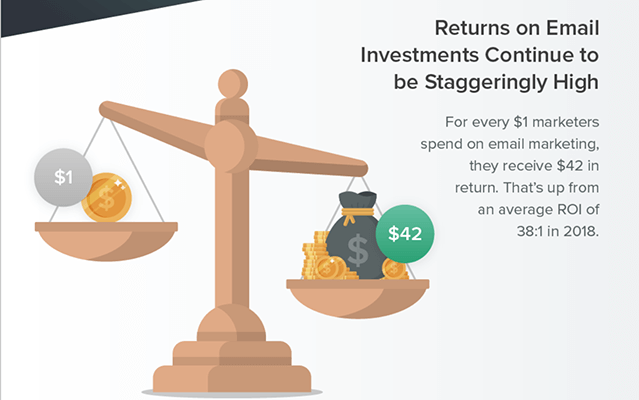
- Control Over Your Audience
Aside from your website, your email list is the only thing you have control over. Social media algorithms can change anytime, but your email list is yours to keep. Unlike social media or other third-party platforms, your email list is an asset you own and control. You’re not at the mercy of algorithm changes or platform policies that can affect your reach and visibility.
- Building Relationships
Email lists allow you to build a relationship with potential customers intimately. Emails wait in someone’s inbox until they’re read, and when you write really useful emails, people might refer to them more than once because emails are easily searchable.
Email allows you to nurture long-term relationships with your audience; you can keep your subscribers engaged and informed over an extended period, which is crucial for customer retention and repeat business.
- Community Leverage
An email list can help build a community around your brand or product. Especially if you are into affiliate marketing that requires your community to buy one or more of the products you advertise before you can earn money as an affiliate.
What Makes an Email List a High-quality
A high-quality email list is essential for successful email marketing. Before building an email list, you must review some best practices first. Here are a few qualities that make an email list high-quality.
- Consent-Based
Before you can consider your email list high-quality, your subscribers must have explicitly consented to receive emails from you. They have either signed up through your website, subscribed to your newsletter, or willingly opted in through another channel.
Your email list should consist of people who have voluntarily consented to receive your emails; this ensures that your emails reach an engaged audience interested in your content and offerings. You must avoid purchasing or sending marketing using lists of email addresses without consent, as this can lead to spam complaints and legal issues.
- Accurate and Current
Your email list addresses should be valid and accurate. You can use email verification tools like Mailfloss or use the double opt-in method to validate email addresses and remove bounced emails. Regularly clean and update your email list to remove invalid, inactive, or outdated email addresses. This method will help you maintain email list accuracy, deliverability and engagement rates.
- Relevant to Your Audience
A smaller but well-targeted email list can be more fruitful than a larger, generic one. When building your email list, focus on attracting people who are genuinely interested in your products or services. This will increase the relevance of your emails and improve your chances of driving engagement and conversions.
- Real and Complete Information
Get real and complete information from real people and avoid buying email lists. Bots, spam accounts, and abandoned email addresses don’t make purchases, so having a list of genuine and active subscribers is important.
- Properly Segmented
A high-quality email list should be properly segmented based on subscribers’ behaviour. Segmenting your email list based on various criteria such as demographics, interests, purchase history, and engagement level will allow you to send more targeted and personalised emails, which can lead to higher engagement and better results.
- Engaged Subscribers
A high-quality email list should consist of subscribers actively opening and interacting with your emails. To assess how engaging your subscribers are, look at metrics like open rates, click-through rates, and conversion rates from your email marketing dashboard. Most email marketing platforms like Mautic allow you to automate the removal or segmentation of subscribers who haven’t engaged with your emails for an extended period.
- Growing
Another factor that makes an email list high quality is growth. You should have a growing email list; you can use strategies like lead magnets, social media promotions and other techniques to attract new subscribers to your email list.
- Easy to Unsubscribe
Another quality of a good email list is the ability to opt-out anytime. Subscribers shouldn’t be stuck in your list; you should allow them to freely opt-out anytime. Make your unsubscribe button pronounced and easy to locate on any device.
How to Build an Email List Using Your Website
Building and maintaining a high-quality email list takes time and effort, but it’s a valuable resource for effective email marketing campaigns. Focus on delivering value to your subscribers, respecting their preferences, and staying compliant with regulations to ensure your email list remains high quality.
Here are the best ways you can build an email list using your website.
- Create and Add a Pop-up CTA (Call to Action) on Your Website
Add a pop-up offer to your website or create a pop-up survey to reach out to visitors on specific pages with surveys related to that content. Adding a pop-up CTA (Call to Action) to your website can effectively engage your visitors and prompt them to take a specific action, such as signing up for a newsletter, purchasing, or requesting more information.
I am not talking about adding annoying pop-ups that disturb users on websites. Pop-ups can significantly boost your email signups and grow your email list at about a 10% rate. To use pop-up forms to get more emails on your website without disrupting the user experience, you can use an “exit intent” pop-up.
These only appear when visitors are about to leave your website, usually by moving their mouse off the page. You can set the pop-up form to stop engaging users or customers already on your email list. This way, you can focus on attracting new customers with your pop-up messages.

- Include Opt-in Form in Your website’s Navigation Bar or Footer
Put an opt-in form in your site’s navigation bar or footer. Embedding signup forms on your website, blogs, or social media posts makes it easy for people interested in your business to quickly share their email addresses with you.
Putting your opt-in form in your website header or footer is a great way to get more people to join your email list. Instead of just having a signup form on your homepage or product page alone, think about putting one on the footer of your website.
Just like we have a simple but clean signup form on our website footer.

To convince more people to sign up, include a clear message about why it’s a good idea, like offering them a coupon, exclusive content, or regular news and updates. When someone is scrolling through your website and reaches the bottom where your brand information is, what kind of offers do you think would make them want to subscribe?
- Offer Incentives
Another way you can build an email list is by creating a compelling incentive or offering discounts and promotions to encourage more people to sign up for your email list. Getting people to join your email list, especially if they’re new to your website, sometimes requires extra motivation. One effective way to encourage people to sign up for your email list is by offering incentives.
These incentives can come in various forms, such as a one-time discount, free shipping, or any other exclusive offer you prefer. However, it’s essential to make these incentives time-sensitive and conditional. This way, visitors are more likely to sign up immediately because they don’t want to miss out on the opportunity.
- Use Humour or Sarcasm in Your CTA’s
Use humour to create personalised CTAs for each blog or landing page instead of the generic Yes and No that most people use in their CTAs copy. Using humour in your email marketing can be a great way to engage your audience and increase your email list.
Personalised calls to action (CTAs) that incorporate humour can catch the reader’s attention and make them more likely to take the desired action. Here are some humorous and personalised CTA ideas you can use to grow your email list:
- “Ready to Laugh and Stay Informed? Join Our Email List – It’s Where the Magic Happens”
- “Don’t Be the Last to Know! Join Our Email List – It’s Where We Share Our Deepest (and Weirdest) Secrets.”
- “Ready to Laugh and Stay Informed? Join Our Email List – It’s Where the Magic Happens!”
- “Become an Email Insider – We Pinky Swear Not to Send Boring Stuff!”
While humour can be a powerful tool to increase your email list signup, aligning it with your brand’s tone and personality is essential. Make sure your humour is appropriate for your target audience, and always test different CTAs to see which resonates best and increase your email list signups.
- Add a Signup Button to Social Media
Adding a signup button to your social media profiles is another smart strategy for building your email list. One of the main reasons people follow you on social media is to know more about your business and new products.
To maintain regular communication with your social media followers, you can offer them the option to receive email updates on platforms like Facebook and Instagram. This way, you give them an extra way to stay informed and connected with them with personalised email campaigns.
Most social media platforms allow you to add a simple email signup option to your profile using buttons or forms. For example, you can include a “Sign Up” button on your Facebook business page to encourage your followers to join your email list. This way, you are converting your social media followers to your email subscribers.
- Ask Visitors to Opt-In at Checkout
Another way to build an email list is to ask your website visitors to opt-in for your list at checkout. Adding a signup form at checkout to build an email list is a common and effective strategy for e-commerce businesses and other online platforms. Collecting email addresses allows you to engage with your customers, send them updates and promotions, and build long-term relationships.
You can add a small checkbox above the checkout submit button to ask users if they want to opt-in for your emails. This will make your signup process more transparent than sending your users unsolicited emails.
- Create Squeeze Pages
You might not be familiar with the Squeeze page, but it’s a lead capture page. It is a single web page designed to squeeze information from a website visitor by restricting access to desired content or offers by placing it behind a lead capture form.
Squeeze pages are a perfect strategy used in digital marketing and online advertising campaigns to build an email list or generate leads. A squeeze page is an effective way to build your email list by collecting email addresses from your website visitors in exchange for your lead magnet.
A squeeze page is a landing page designed to collect email addresses from your visitors. It is a short-form landing page with a headline, short supporting text, and a form including one or two fields for name and/or email address. The main purpose of a squeeze page is to convert visitors into email subscribers.
To achieve this, in your squeeze pages, you must offer content, a lead magnet, in return for the visitor’s email address. The key to an effective squeeze page is a quality lead magnet that will convince prospects to hand over their email address.
- Utilise Loyalty and Referral Programs
Loyalty and referral programs are another great way to build an email list. Building an email list can be challenging, but you can use loyalty and referral programs as effective strategies to grow your email list. With rewards, you can encourage new and existing subscribers to upgrade, generating more lifetime value on your website.
Here are some ways to use these programs to build your email list:
Using Referral Programs:
- Ask your existing subscribers to refer their networks to your email list
- Offer rewards to customers who successfully refer a new customer.
- Design a cost-effective rewarding structure
- Use referral software (affiliate manager) to manage subscribers, track referrals, and send rewards automatically
Using Loyalty Programs:
- Offer exclusive content or discounts to loyal subscribers
- Send personalized emails to subscribers based on their behaviour and preferences
- Use segmentation to target specific groups of subscribers with relevant content.
- Measure and analyse the performance of your loyalty program to optimise it.
How to Build an Email List Using Social Media
Building an email list using social media handles can grow your audience and reach more potential customers. Social media marketing is one of the best ways to drive traffic to your website and generate leads. Here are some social media strategies you can use to build your email list:
- Embed Signup Buttons on Social Accounts.
The most cost-effective way to build an email list using social media and convert your social media followers to your email subscribers is to add a call-to-action to your social profiles. For Instance, you can add a “Sign Up” button below your social media profile on Facebook and Instagram for followers to join your email list.
- Promote a Giveaway and Contest
Another smart way to build an email list is to offer a giveaway or contest on social media and require participants to sign up for your email list to enter. You can use social media features like Instagram stories to run polls, quizzes, and Q&A to generate user engagement and build your email list. You can direct traffic to a landing page on your website for your followers to sign up for your email list by promoting a contest and giveaway on social media.
- Use Targeted Ads on Facebook
You can use Facebook ads to target potential subscribers and direct them to a landing page where they can sign up for your email list. With Facebook lead form ads, followers can subscribe to your email list without leaving the platform. The conversion rate of the Facebook lead-form ads is high.
- Host a Social Media Live Event
Another way to build an email list using social media is to host a live event on social media and encourage viewers to sign up for your email list for exclusive content or offers. When they know they will get something special that’s not in a public place when sign up for your mailing list, they will gladly offer their email in exchange for your exclusive lead magnet.
How to Build an Email List Offline
Building an email list offline can be an effective way to reach potential subscribers who may not have found your business online. You don’t have to run an online business alone before you can start building email lists. With Brick and Mortal store, you can effectively convert your foot traffic into email subscribers.
Here are some strategies to build an email list offline, especially when you run a physical store:
- In-store Signup Sheets
If you have a physical store, you can place a signup sheet at the checkout counter or other visible areas to collect email addresses from customers. You can convert physical store foot traffic to email subscribers using signup sheets at your store or checkout desk. Or when someone needs an item that’s currently unavailable, you can ask them to sign up for instant notification once the item arrives. But ensure they willingly give you their email address. Just make sure you get their full consent when collecting this information offline.
- Events and Trade Shows
You can organise events and trade shows related to your business and collect email addresses from attendees who are interested in your products or services. Trade shows are another way to build an offline email list and network with people from different backgrounds. You can collect email addresses by hosting giveaways of your products at an event. You can also embed a barcode on your business card to encourage the easy signup process.
- Book a Stall at a Fair
Another way you can build an email list offline is to book a stall at a trade fair in your locality and collect email addresses from people who visit your booth so that you can stay connected with them with your products or services after the trade fair. Make sure to have a simple form that allows people to enter their name and email address quickly.
- Sponsor a Seminar
Sponsoring a physical seminar is another way to build an email list offline. You can sponsor a workshop related to your business and collect email addresses from attendees who show interest in your products or services.
Best Practices to Follow When Building High-Quality Email List
Building an email list is essential to any marketing strategy but requires patience and a well-planned strategy. Here are some recommended practices to follow when building your mailing list:
- Choose a Reliable Email Marketing Platform
Carefully select an email marketing platform you can grow with and rely on its features to create engaging emails. There are many email marketing platforms you can pick from, but not all of them will give you the features you require to build and nurture your leads.
- Create a Compelling Incentive
Gone are the days when people give email addresses out freely; they expect something special from you before they can give you their email address. You must offer your audience a compelling reason to subscribe to your email list, such as a discount, a sales notification, exclusive content or some other form of value in exchange for their email.
- Segment Your Audience
Divide your email list into smaller groups based on demographics, behaviour, or preferences to create more personalised and targeted email campaigns. Segmenting your email list allows you to send emails to users based on what they like most.
- Use a Double-opt-in Method
Use a double-opt-in method or email verification tools to verify the authenticity of their email addresses and ensure that subscribers are genuinely interested in receiving your emails.
- Set up a Welcome Sequence
Use a welcome sequence to introduce new subscribers to your brand and build a relationship with them. Immediately a subscriber lands on your list, send a welcome email and work to retain them. Nurturing your leads is important in keeping them glued to your business. Craft compelling and captivating welcome emails to introduce new subscribers to your business.
- Pitch Your Email Newsletter with Social Proof
Social proof is a powerful method to build trust with new subscribers and drive conversions. Incorporating social proof into email list building can help you validate your list’s credibility and increase your email list. Use numbers to show how many people have already subscribed to your email list to build trust and tempt new people to sign up. You can use copy like “Subscribe to our mailing list and join over 100,000 people in our community.”
- Don’t Purchase an Email List
Purchasing an email list is illegal and a guaranteed way to have your emails end up in a spam folder. Using purchased email lists for marketing is generally a bad idea and can negatively affect your business. Instead of buying email lists, building your own email list by offering valuable content and incentives to your website visitors and customers is better.
Building your email list from scratch may take more time and effort, but it will result in a list of organically interested customers who are more likely to engage with your emails and become loyal customers.
- Data Privacy and Transparency
Clearly communicate your data usage and privacy policies to build trust with your audience. Ensure compliance with relevant data protection regulations like GDPR, CCPA or your country’s data protection policies.
- Feedback Surveys
Ask for feedback from your subscribers to understand their preferences and improve your email marketing strategy accordingly.
- Exit Surveys
Use exit surveys on your website to gather insights from visitors who don’t subscribe. This information can help you improve your sign-up process to increase your email list.
- Analytics and Tracking
Monitor your email list growth with analytics tools to identify what’s working and what isn’t and adjust your strategy accordingly.
- Email List Clean-Up
Regularly remove inactive subscribers from your list to maintain a healthy email list and improve your email deliverability.
Building an email list from scratch takes time, but following these best practices can create a high-quality, engaged, and effective email list that drives sales for your business.
Bonus: Best Open-Source Marketing Tools for Managing Your Email List
Managing your email list is a crucial part of any email marketing strategy. Open-source marketing tools are the most cost-effective and customisable solutions for managing your email list.
Open-source marketing tools provide reliable automation and consistency to create personalised, unique marketing campaigns for your subscribers. Open-source marketing automation tools enable you to streamline your marketing processes, support campaigns, and increase overall user engagement.
Related: Free and Open-Source Tools to Automate Business Operations
Here are some of the best open-source marketing tools to cover any task your business may need to handle.
Mautic is a popular and advanced open-source marketing automation platform with robust email marketing capabilities. You can use Mautic to manage your email lists, create email campaigns, track email performance, and segment your audience. It also offers features like A/B testing and marketing automation workflows.
Here is a detailed article on why Mautic is the best email and marketing automation platform
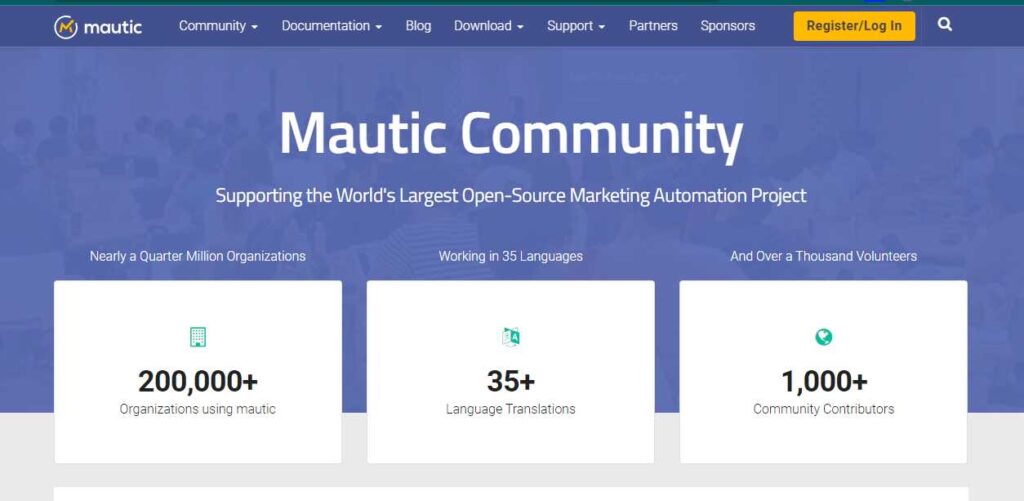
Mautic Features Include:
- Lead Management
- Multi-channel campaigns
- Advanced Contact segmentation
- Focus item
- Contact scoring
- Social Media Integration:
- Page Builder
- Landing page builder
- A/B Testing
- Mautic forms
- User activity tracking
- Dynamic content
- Cross-platform integration
- Campaign Tracking and Analytics
- API and Integrations
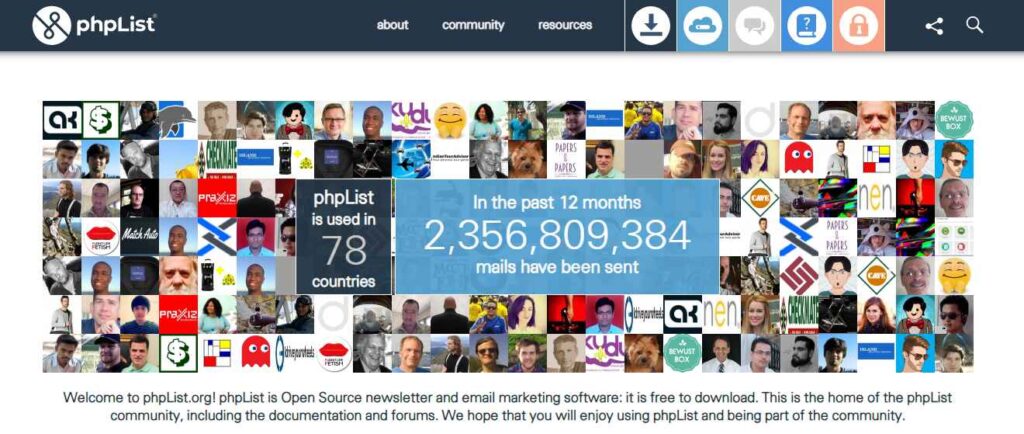
PhpList is an open-source email marketing and newsletter management tool. It provides features for managing subscriber lists, creating and sending email campaigns, and tracking open and click-through rates. It’s known for its simplicity and ease of use.
PhpList features include:
- Contact Management
- Email Campaigns
- Template Editor
- Tracking and Reporting
- List Segmentation
- Automated drip campaigns
- Multi-Language Support
- Integration and Plugins
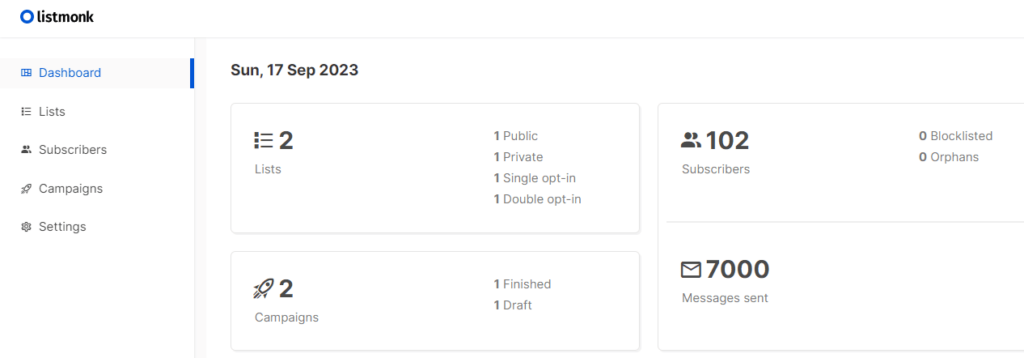
Listmonk is an open-source, self-hosted email newsletter and marketing automation tool. It is designed to be easy to set up and use and offers features like list segmentation, campaign scheduling, and detailed analytics. It also supports transactional email sending.
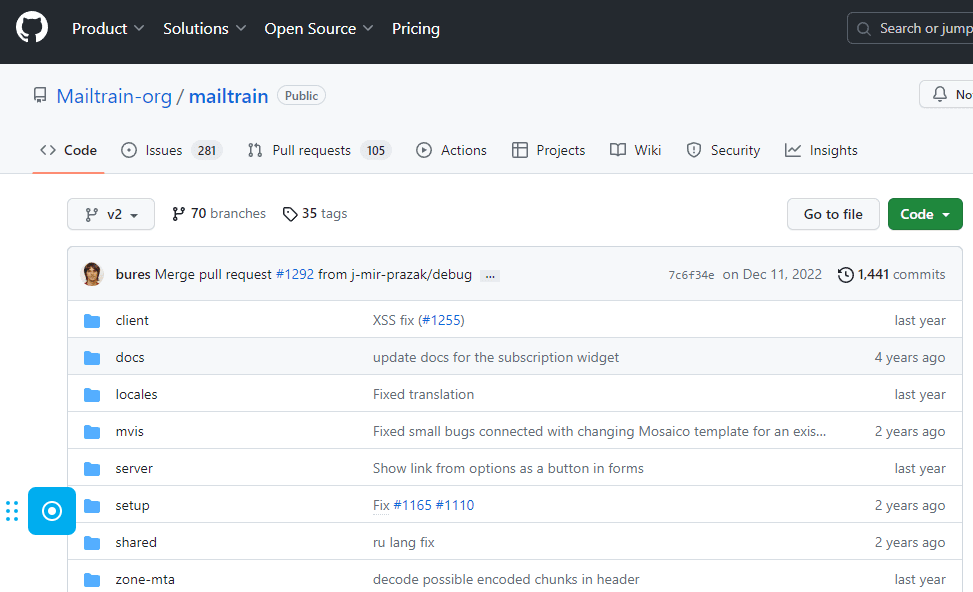
Mailtrain is a self-hosted open-source email marketing application focusing on simplicity and ease of use. It allows you to manage subscribers, create and send campaigns, and track email performance. Mailtrain can be integrated with various email-sending services for deliverability.
Mailtrain’s Top Features include:
- Email Campaign Management
- Mailing List Management
- Segmentation
- A/B Testing
- Automation
This is another open-source and free email marketing software that has no limits to the number of subscribers created. It has a fluid and simple UI, bounce management, mail and link tracking, and automated data import and export. It is designed to help you create and send email campaigns, track performance, and engage with your subscribers effectively.
OpenEMM features include:
- Email Campaign Management
- Subscriber Management
- Autoresponders
- SMTP Server
- User Access Control
- Automation
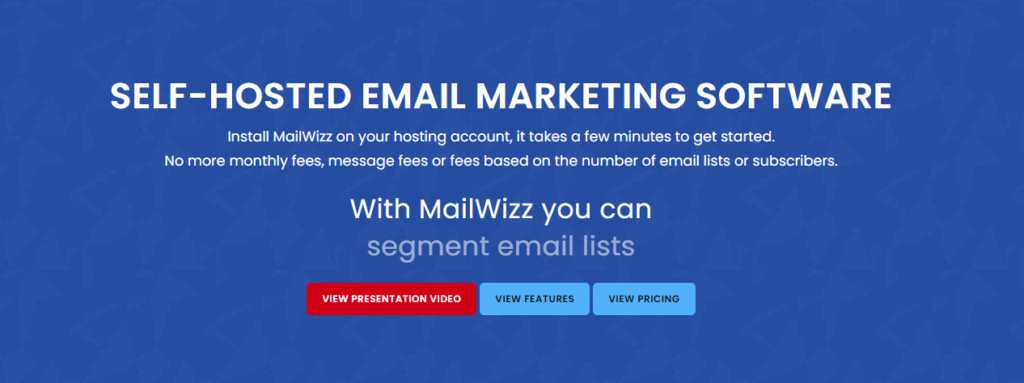
MailWizz is not an open-source email marketing software. It is a one-time paid commercial email marketing solution that allows you to send email campaigns, manage subscribers, and track email marketing performance. MailWizz offers a paid license for its software, and users typically need to purchase a license to use it.
MailWizz features include:
- Email Campaign Management
- Subscriber Management
- Advanced Segmentation
- Autoresponders
- Delivery and Tracking
- Integration
- API Access
- Role-Based Access Control
Related: Best Free and Self-hosted Email Marketing Software
Final Thoughts on Building a High-quality Email List from Scratch
You have learned how to build high-quality email lists from scratch, but remember that people only subscribe when they know they will get value in exchange. If you’re building an email list from zero, the process might seem impossible or difficult. You can organically grow your subscriber base by employing methods such as fostering strong social media engagement, creating valuable content, and leveraging partnerships and collaborations.
You must understand that building an email list is like nurturing a secret garden of possibilities; each email address is a seed of potential connection, website traffic, business growth, and conversion. As a gardener tends to their plants carefully, so must you tend to your email list, nourishing it with valuable content.
You must understand that your email list is not just a collection of names and addresses; it’s a community of individuals who have entrusted you with a precious part of their digital lives. It’s a testament to your dedication, creativity, and the genuine relationships you’ve built in the vast landscape of the internet.
Email list gives you the power to inspire, educate, and connect with people in ways you never imagined. It’s a canvas for your ideas, a stage for your stories, and a bridge to hearts and minds across the digital marketing field.
So, remember, as you continue to build and grow your email list, you’re not just building a list; you’re building a connection to turn each email address into a loyal and paying customer.
Frequently Asked Questions on How to Build Email List
Building an email list is important in growing your business visibility, maintaining consistent communication with your audience, promoting your products or services, and driving conversions.
Here are answers to some of your frequently asked questions on how to build an email list.
Can I buy an Email List?
No, it is not a good idea to buy an email list. Purchasing email lists goes against best practices in email marketing and can lead to several negative consequences. I always advise my clients against buying email lists.
Purchasing email lists shouldn’t be mentioned around any serious business or brand, no matter the size. It is considered unethical by every marketer and can potentially lead to legal and reputational issues
What are the negative effects of buying email lists?
Using purchased email lists for marketing campaigns is generally a bad idea and can have several negative effects on your business.
Here are some reasons why:
Violating consent rules:
Purchased email lists often include contacts who have not consented to receive emails from you, which can make you non-compliant with data privacy legislation like GDPR.
Harming email deliverability:
Sending emails to purchased email lists can harm your email deliverability and IP reputation, as recipients may mark your emails as spam.
Compromising brand reputation:
Contacts on a purchased email list don’t know you, and receiving unsolicited emails from your business can be annoying and damage your brand reputation.
Damaging list quality:
Purchased email lists often include outdated email addresses or bad domains, which can spike your email bounce rate and harm your email performance. Bought email lists often contain obsolete, inaccurate, or irrelevant email addresses. This means your marketing messages will reach people who haven’t expressed interest in your products or services, leading to low engagement rates and a negative brand perception.
Penalisation by email service providers:
Email clients like Gmail, Yahoo!, and Outlook don’t want to be associated with accounts that recipients repeatedly flag as spam, and your email service provider, like AWS, can penalise you based on the negative effects of purchased lists, including spam complaints, bounces, and block.
Low Conversion Rates: Even if you manage to get emails delivered to their inboxes, the conversion rates from a purchased list are typically very low. Contacts on purchased lists are often unresponsive to unsolicited emails, and they may not trust your brand or be interested in your products and services.
Legal Compliance:
In many countries, buying email lists without explicit consent from individuals is illegal. It violates data protection laws, such as the General Data Protection Regulation (GDPR) in Europe or the CAN-SPAM Act in the United States. Non-compliance can lead to significant fines and legal consequences.
Instead of buying email lists, focus on organically building your list by attracting subscribers genuinely interested in your content, products, or services. Create valuable lead magnets, optimise your website for conversions, and use ethical and legal means to collect email addresses. This approach will yield a higher-quality and engaged email list, leading to better long-term results and a positive brand image.
Can you build an email list without a website?
Yes, you can leverage social media and offline methods to build an email list even without a website. However, having a website provides more opportunities for content creation, personalised messages, and driving traffic to the website with your email list.
How can I create value to attract subscribers?
To attract subscribers, create value-packed content that addresses their needs and interests. You can also offer freebies, such as checklists or eBooks, that provide useful insights and help your audience achieve specific tasks.
How long does it take to build an email list from scratch?
Building an email list from scratch takes time and effort and won’t happen overnight. However, by implementing effective email list-building strategies, you can start seeing results within a few short hours or days.
How can I segment my email list for more targeted marketing campaigns?
You can segment your email list based on various factors such as demographics, interests, or purchasing behaviour. Segmentation allows you to tailor your content to specific groups, resulting in more relevant and effective marketing campaigns.





0 Comments